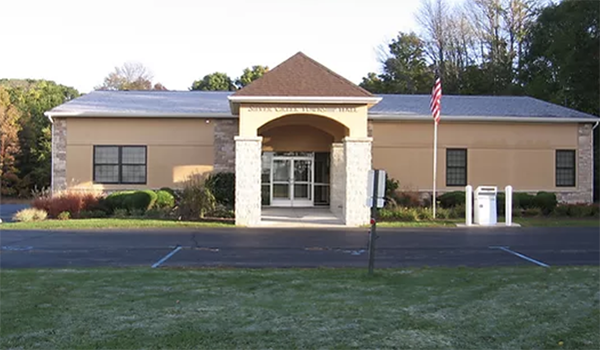What to do with nuke waste?
Published 11:36 pm Thursday, October 13, 2011
CASSOPOLIS — Earthquakes in Japan and Virginia brought storage of nuclear waste back to the forefront.
“The last thing you’d want to do would be to build a new reactor,” Mary Olson, a 20-year Nuclear Information and Resource Service (NIRS) staffer from North Carolina, told six people at a forum Thursday night at Cass District Library.
The site for a national nuclear waste dump at Yucca Mountain — a bill originally sponsored by Cass County’s Rep. Fred Upton — failed, leaving tons of waste sitting at reactor sites across the country.
“They’re so not cost-effective,” Olson said. “They’re one of the worst uses of money in terms of the amount of power you get back. The fastest and cheapest way to reduce greenhouse gases is to start using the energy we’re wasting. Efficiency is 12 to 90 times, depending on which piece you look at, more cost-effective per dollar put in, and reduces greenhouse gas, than nuclear.
“Unfortunately, we have a totally nuclear president. (Barack Obama) rode into town on a nuclear horse and is not going to get off. There’s a whole fleet of reports that confirm this, but I’m deeply worried about meeting the climate goal. No, I don’t like coal, either, but if you site a new reactor it takes five to 10 years; best case scenario, five years for construction, so we’re up to 12 years; and then you have to run the thing at full tilt for 15 years to pay the carbon debt associated with making the fuel and all the concrete, steel and other components. You’re up to 27 years before you get a single carbon offset, while pumping in $10 billion to $12 billion. The good news with solar and wind is you can do it incrementally. The other really good thing is retail solar is cheaper now per unit of energy than nuclear.”
Currently, reactor owners sign a contract with the U.S. Department of Energy (DOE) to collect fees from customers — one tenth of a cent per kilowatt hour — and to store irradiated (waste) fuel on-site until the DOE takes it — which was supposed to happen 13 years ago in 1998.
When the DOE “accepts” waste, it becomes the property of taxpayers. With only a few exceptions, such as the melted Three Mile Island fuel from 1979, this has not yet occurred.
Reactor owners sued DOE for breach of contract, but Olson said nearly all high-level waste (containing 95 percent or more of the radioactivity) remains sitting at reactors where it was generated.
This is known as “decentralized interim storage.”
Irradiated, or “spent” nuclear fuel at reactors is either in wet fuel-pools or in dry “casks.”
Wet storage is required for the first five years due to the enormous thermal heat generated by radioactive decay, which will continue at some level for centuries.
After five years, moving the waste to dry storage reduces risk of fuel pool fires, like Fukushima unit 4, and explosions, like Fukushima unit 3.
President Obama canceled the Yucca Mountain proposed national nuclear waste dump in Nevada on Western Shoshone Treaty Land.
Olson said Yucca would have failed to isolate waste from the environment, so was glad to see it scrapped.
However, that makes the storage and long-term disposition issue an open-ended question.
A Blue Ribbon Commission on America’s Nuclear Future (www.brc.gov) was appointed for a two-year term by Secretary of Energy Chu to make recommendations on new radioactive waste policy.
Olson said all BRC members are associated with the nuclear industry in some way.
More than 150 organizations supported a call for improving “decentralized interim storage” with better design/low-cost upgrades to dry storage at reactors.
These recommendations “clearly recognize reactor sites as temporary/‘interim’ storage sites, not suitable for permanent waste ‘disposition,’ ” she said.
To centralize storage, very highly radioactive irradiated (“spent”) fuel would be put on trucks, trains and barges and shipped to one or more storage sties, where the same dry-cask storage would be employed.
Current law prohibits this type of storage facility at any site being considered for a permanent repository, therefore centralization to another “interim” site, by definition, increases the total transport of the waste.
Olson pointed out that the Great Lakes basin contains 10 nuclear power plant sites with 13 reactors (including Palisades and Cook units 1 and 2) and three sites with 20 reactors in Canada — 33 total.
Unless and until all reactors are closed, Olson said, centralization of storage will not result in “all the waste in one place,” it will simply be in one more location since every reactor site will have at least five years of waste in the wet storage pool and likely more since transport of the existing backlog of waste would require decades to accomplish under perfect conditions.
“The mythology that taking care of the waste in one location does not reflect the increased security risk that a very large storage site might attract or the ease of an air attack,” she said. “Centralizing the waste also opens the door for internal security issues, such as the push to recover plutonium from this waste. Many options for using plutonium as fuel exist, but since the ownership would be transferred to the federal government, the diversion of this massive quantity — 600 tons and growing — of weapons-usable plutonium into a weapons program is a very real risk.”
The technical term for separating plutonium from irradiated fuel waste is “reprocessing.”
Reprocessing is not recycling, Olson said.
Only one percent of the waste can be re-used (the plutonium). Ninety-nine percent of the waste cannot be reused and is a greater liability as it is now caustic liquid or highly radioactive metals where the original fuel waste is a metal-clad ceramic and relatively easy to containerize.
In addition to the BRC, the U.S. Nuclear Regulatory Commission is “being busy beavers” on waste storage, according to Olson.
It adopted a “study period” of up to 300 years for “extended storage” on-site.
There is no indication that new regulations will allow storage that long — but current regulations give licenses in increments of 20 years up to 120 years total.
A hardened on-site proposal came from Northeast communities that were successful in winning closure of reactors.
In the wake of Sept. 11, 2001, these activists realized that the security of the waste at all reactors, but particularly the closed sites, needed improving.
Some communities are calling for storage at closed reactor sites until there is a permanent site for isolation of the waste for as long as it will be hazardous, so the waste can be moved one time only.
Olson said there is a “new urgency” to support development of a permanent site so the waste can be moved before rising tides begin to impact coastal sites.







